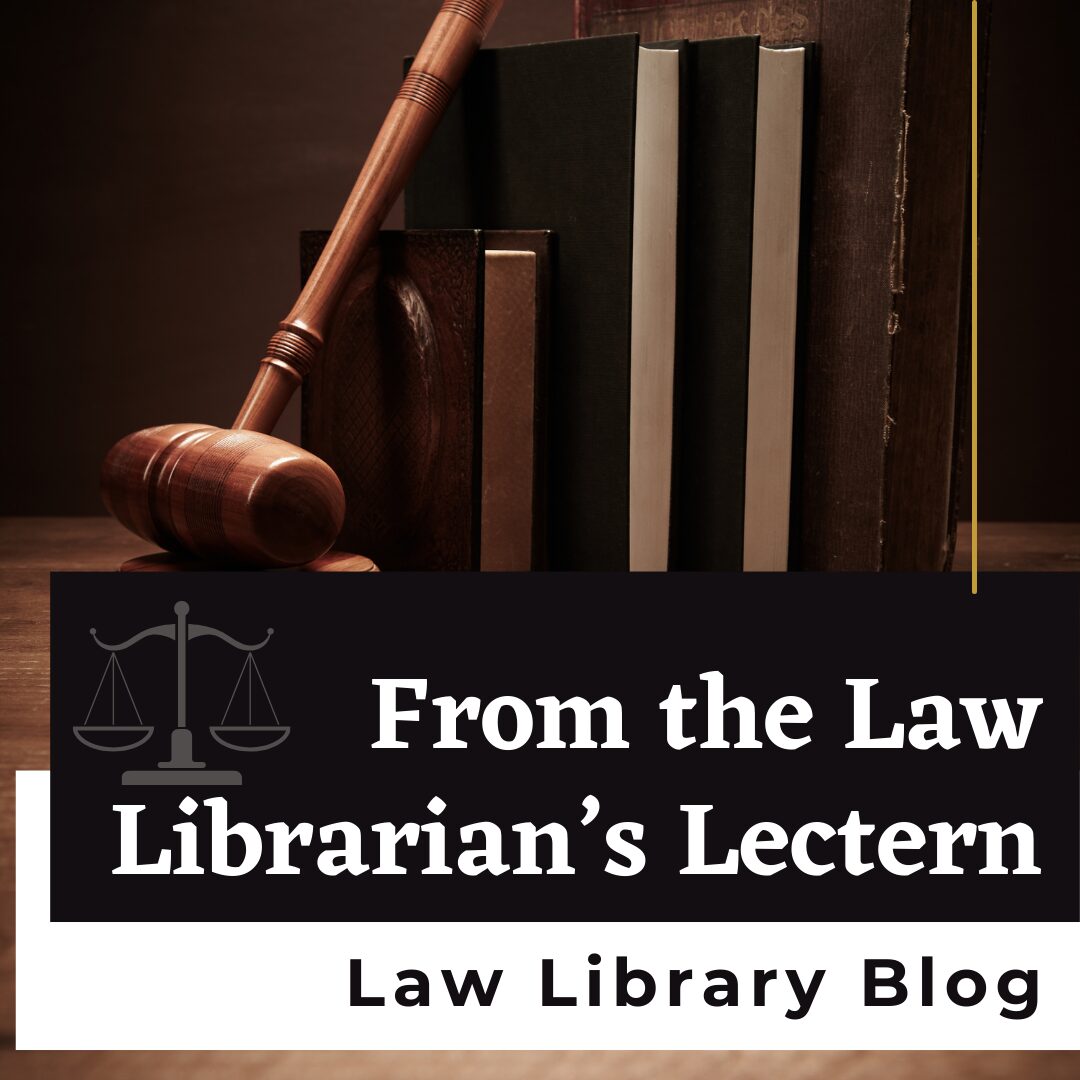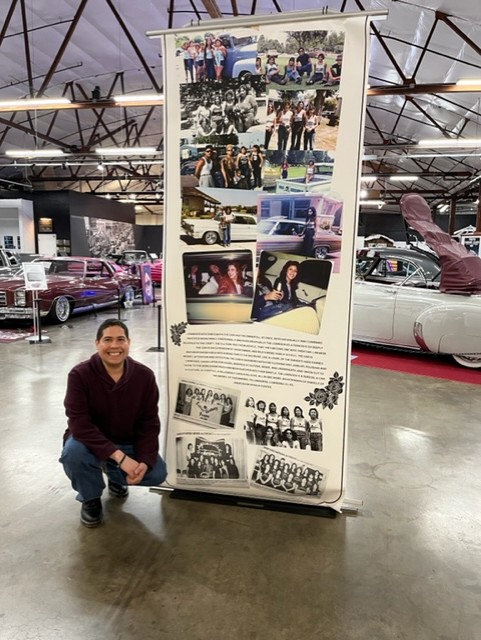by Jonathan Watson On January 27, 2024, I had the pleasure of attending the…

From the Law Librarian’s Lectern: The Legal History of Lowriders (May 2024)
by Jonathan Watson

Did you know that the California Automobile Museum in Sacramento featured the special exhibit “Rucas y Carruchas: Ladies in Lowriders”? The exhibit was managed by Shavolla Rodriguez, who was among several women featured in Andri Tambunan’s article “Low and Slow” in the January-February 2024 issue of Sactown Magazine. According to Rodriguez, “…a lot of older women…saved up and bought their cars…[and] had to wait until their kids were grown, because as women, [they] had to put…family, kids, and household first”.
In the above mentioned article, Lina J. Moreno recollected that “all [of her] siblings in the family always had lowriders”. When asked what a lowrider represents, Olivia Fonseca stated that it is “an enjoyment that you can’t replace with a Tesla or BMW. I look at my lowrider as an investment to pass on to my daughter…”
According to Hernandez (2021), cruising and lowriders originated in Southern California post-WWII as an art form and a communal activity among Chicanos. Despite its California roots and catching the attention of the mass media by the 1970s (Stone, 1990), lowriding culture has not always been embraced—perhaps due to it being “…an expression of “Mexican-ness” or chicanismo [the essence of being Chicano]…[and its engaging of]…the dominant culture in an aesthetic and ideological discourse…” This might be why, as Maani (2024) stated, California Vehicle Code §24008 had been passed in 1958 to ban the modifying of a car to make the frame lower than the bottom of the wheel rims.
In 1979, Roberto Y. Hernandez (who later founded The San Francisco Lowrider Council in 1981) and other lowriders sued then-mayor Dianne Feinstein and the San Francisco Police Department for the violation of their civil rights. As a litigant, Hernandez claimed to have been beaten and arrested at least 113 times. The case was eventually settled, and lowriders were permitted to cruise in San Francisco. Yet, in 1988, it became legal for local governments to pass ordinances prohibiting cruising. For instance, Ordinance 1360 §1 was passed the same year, which defined and prohibited “cruising” in the Vacaville Municipal Code. Comparatively, in 1985, Ordinance No. 85-19 added cruising as a prohibited activity in the Fairfield Municipal Code. As of January 2024, California Assembly Bill 436 (2024) made it so that bans and anti-cruising ordinances are prohibited.
According to Ross (2005), lowriders began expanding beyond California, New Mexico, and Texas and into Florida and the East Coast. In NPR’s “The Lowrider Culture…Global Boundaries” (2024), Professor Denise Sandoval stated that “lowriding definitely is global…Japan has been part of the community since the ‘90s…places like Brazil…Spain and…Paris[, France] and Belgium…[are] using their cars to express themselves…” Lowriders have even spread to the United Kingdom, Thailand and the Philippines. In 2012, Lowrider Magazine celebrated its 35th anniversary. Lowriders have been featured in “Jay Leno’s Garage”, and Latina aesthetics have even influenced celebrities such as the late Amy Winehouse.
Forté, Joiner & Williams (2023) trace the history of African Americans and lowriders in San Diego. More so, the National Museum of African American History & Culture even devoted a page to lowriders. Strait addresses how lowriders began appearing in the music videos of West Coast hip hop artists during the 1990s. There is also an article about how lowriders have replaced horses at the annual Crow Fair and Rodeo in Montana.
Even if you do not own a lowrider, you can still access the following materials (if you do not have a Solano County Library card, you can apply for an e-card to access any of the below databases):
· For cultural analyses, you might read academic works such “The Performance of Chicano Masculinity in Lowrider Car Culture: The Erotic Triangle, Visual Sovereignty, and Rasquachismo” (Chavez, 2013), “Cruising The Borderlands: Queer Latinx Creating Space in Lowrider Culture” (Campos, 2015-2016), and “‘Who Says Lowriders Are Only For Men?’”: Lowriders In Las Vegas, Nevada” (Herrera, 2022).
· For a comprehensive historical analysis, you might request Charles Tatum’s book Lowriders in Chicano Culture: From Low to Slow to Show or Dylan T. Miner’s book Creating Aztlan via Solano County Library’s Link+. You can also find Sagrado…Chicano Homeland, which features poetry by Levi Romero. Romero, New Mexico’s first Poet Laureate, often mentions lowriders in his works.
· Lowrider-related albums to freely listen to on Solano County Library’s Freegal Music and Hoopla Digital. Although the database features only cover versions of lowrider classics such as William DeVaughn’s “Be Thankful for What You Got” and WAR’s “Low Rider”, you can still find music by legends such as Santana and contemporary artists like Trish Toledo.
· Film buffs can find La Mission (starring Benjamin Bratt) on Hoopla Digital and physical copies of Lowriders (starring Demian Bichir and Eva Longoria) at Solano County Library branches.
· If you are a budding lowrider, did you know that Auto Repair Source freely provides data for vehicles as far back as 1974? Or that Hoopla Digital carries the How-to Performance series that focuses on autos such as Chevrolets?
· For children, be sure to find the Lowriders in Space series at the branches or Libby Overdrive. You might check out too the nonfiction books about lowrider history on Hoopla Digital intended for children, or the titles such as San Diego Lowriders…Cruising (Pulido & Reyes, 2017) that are geared toward an older readership.
· Check out MasterFile Complete (EBSCO) for articles pertaining to lowriders. You can find the pieces by Stone (1990) and Ross (2005) that were cited above. Others such as Bright (1997) wrote about how “nightmare murals [featuring icons such as Freddy Krueger] are in marked contrast to those seen on Chicano low riders in the seventies when the Chicano movement’s poetics of cultural nationalism provided the basis for the resistive and affirmative poetics embodied in the figures of the Virgin of Guadalupe, Aztec warriors…” In NewsBank, you can even find articles such as “Opinion: Lowriding brings the Filipino and Chicano communities together. Here’s the history” (Obaña, 2023).
This blog posting is for informational purposes only and is not intended to substitute for legal advice. Please consult with a legal expert for the best guidance.
